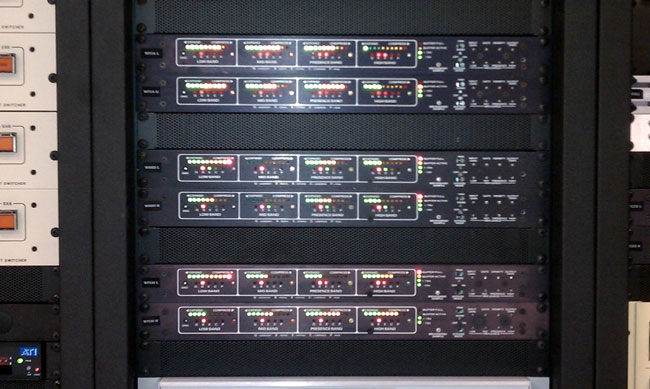I give to you, the original Texar Audio Prism:

I love the sound of these units when coupled with an Optimod 8100A. Many people have (or rather, had) difficulty setting these things up. I found them to be very easy to deal with, just follow the instruction manual. If that doesn’t sound good, then there is something wrong with the unit. Over the years, there are only a few consistent problems. The first thing is with the voltage regulators. They have heat sinks attached with nylon screws. The screws get brittle and fall apart, making the regulator overheat and go bad. I have taken to replacing the nylon screws, and if the heat sink has fallen off, the entire regulator. There are also a few electrolytic capacitors in the power supply and on the audio board, it is always a good practice to replace those. Otherwise, unless the unit has been blown up by lightning, it should work.
As for set up, follow the directions in the manual:
- Bypass the units using the bypass switch
- Turn on the onboard pink noise generator
- Using the test ports on the front of the unit, plug a Simpson 260 VOM set on 2.5 VAC important: use the ground port on the front of the unit, not the case
- For use with an Optimod 8100A, using the dB scale on the Simpson 260, set all the bands for a 4.0 reading. Set the density to 3/4.
- Turn off the pink noise generator and switch out of bypass mode.
- Make sure the levels in the studio are where they should be.
- Adjust the input gain so the “Buffer Active” light does not come on during normal-level programming.
- Adjust the output levels so that the input buffer on the Optimod reads between -7 and -3 vu.
The rest of the settings are on the Optimod:
- Clipping = 0
- HF limiting = 5
- Release time = 2
- Bass coupling = 2
- Gate = 0
- Set the input attenuators for about 10 dB total gain reduction, with peaks around 15 dB or so.
Then set the L-R null. To do this, make sure the program material is in mono, then adjust the L or R input attenuator for minimum reading. Also, if the Audio Prism has PR-1 (phase rotators) installed, bypass the phase rotator in the Optimod. There is also a replacement card 5 made by Gentner called the RFC-1 for the Optimod 8100A. I notice little difference between a stock Optimod and an RFC-1 Optimod.
That is a good starting point. Most people are quite happy with this, but if needed, the high and low settings on the Prism can be adjusted slightly to suit the station equipment. When properly adjusted, this equipment rides gain, and adds a certain amount of loudness, while keeping the programming material natural sounding. Further, unlike some “modern” air chain processors, it does not boot up and it does not occasionally lose its mind, requiring a reboot.
The best paragraph in the manual, or any broadcast equipment manual is this:
There is a wealth of information available in the LED display. A few minutes of watching them in reduced light (emphasis added) while listening to a familiar program input will greatly help in understanding their action.
It will also greatly enhance your buzz, dude. It was the 70’s.
